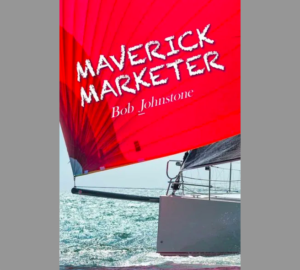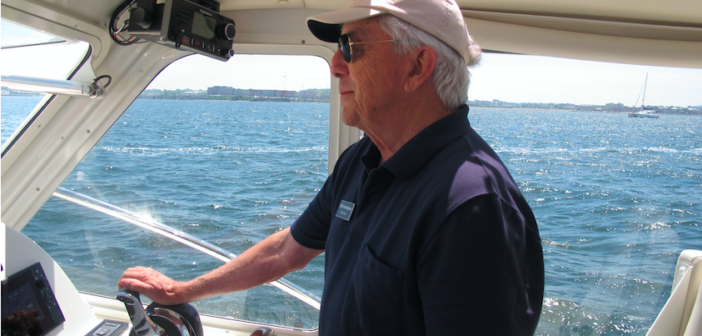If it’s appropriate to apply a boating term to a human being (and in this case it is), Bob Johnstone is a one-off, a combination of a world-class sailor, prize-winning marketing genius, and sharp-minded entrepreneur (starting two boat companies, one sail, one power, plus a highly profitable graphic arts business). Now that he’s 89 years old, Johnstone is also a published author, with the new Maverick Marketer (398 pages, Palmetto Publishing) under his belt.
The book is a pleasure to read, largely because it reflects Johnstone’s wide-ranging intellect, humor and collected first-hand wisdom from both the business and boating worlds. This is hardly the typical corporate or boating biography. Johnstone quotes Steve Jobs saying that good products are “triumphs of taste,” and Jeff Bezos saying that it’s much better to work with missionaries than with mercenaries; there is also some advice from Harvard B School professors scattered among the pages.

But throughout, sailing as been his life. Johnstone counts at least two pirates as ancestors, and his father took him sailing when he was 2 in Glen Ridge, New Jersey. He filled his notebooks with drawings of sailboats, with a “RJ” initials on the main, in the first grade.
He sailed and he sailed. He met his future wife (and sailing and business partner as well) Mary in his summer job after his freshman year at Princeton as a sailing instructor on Fishers Island, New York. Mary, on her way to her freshman year at Smith, was working as an au pair for a family there; the kids wanted to learn how to sail.
After Princeton and the Army (and a few hours at the CIA), Johnstone went to work for Quaker Oats in Columbia and Venezuela. When they called him back to their Chicago offices, he was nonplussed to find that he was assigned to be the brand manager for Ken-L Ration dog food. At the time, Quaker was not happy with the brand’s performance; it was losing market share.
Johnstone writes that it was “Time To Get Creative” (a frequent theme of the book). The human market for cheeseburgers was taking off at the time. Johnstone’s idea was to create Ken-L Ration Cheese Flavored Burgers for dogs. Dog owners bought $30 million of the burgers the first year; they became number one in market share, and Johnstone was named Quaker’s “Marketing Man of the Year” in 1968. (Johnstone created ads and marketing campaigns the rest of his life.)
Not surprising, the Quaker job lost its luster, and one day Johnstone, after noticing black-and-white nature photos on the walls in the company cafeteria, had a better idea. He quit, and he and Mary took out a $10,000 loan on their house in Wilmette and started Naturescapes, creating four-color photomurals of nature scenes measuring as large as 9 x 14 feet. Their garage became a distribution center, with their son Peter, 7, and his friends packing boxes for $2 an hour.
In 1975, he got a call from a headhunter, “a game changer,” he writes, offering him a job as marketing VP for AMF Alcort, the makers of Sunfish. “Why not align my hobby with my vocation,” he thought. He had already started a Sunfish fleet in Venezuela and was their national champion two times.
Johnstone took the AMF job, but kept an anchor to windward. Mary (who’d been an assistant store manager for Crate & Barrel), took over Naturescapes. It eventually paid for their children’s college educations and bankrolled the first-year startup of J/Boats.
Johnstone was restless in the corporate world of AMF, and in 1977 joined his brother Rod, who had designed a boat that became the J/24, in founding J/Boats in Newport, Rhode Island. Johnstone invested $10,000 in cash and combined that with Rob’s $10,000 worth of design work for a 50-50 partnership in J/Boats Inc. He writes that they also had an “in-house” capitalist in Mary, who was then making $140,000 a year running Naturescapes. That initial $10,000 covered the first advertising, a demo J/24 and boat shows; they didn’t have enough positive cash flow to pay themselves for nine months.
J/Boats, of course, made sailing history. They sold 750 J/24s the first year; today there are 5,500 J/24s sailing somewhere; the company has made 9,500 other boats from the J /22 to the J/65. J/Boats have won races around the world and more than 20 boat-of-the-year awards.
As the years went by Johnstone, and Mary, got older, and stiffer. They still sailed but, as he writes, the prospect of heading from Boston to Newport on a dark and stormy night was losing its allure. For their 40th wedding anniversary in 1996, he bought a 1993 Dyer 29 for $84,000 and named it Grace, in honor of Mary’s profession as a minister. They bought other Dyer 29s in the ensuing years.
By the turn of the century, things were changing at J/Boats, and Johnstone started thinking about starting a new powerboat company on his own. His son Peter was already talking with Doug Zurn, the designer, about building a 34-foot powerboat alongside Peter’s Gunboat sailboats in South Africa.
Johnstone and Mary started making lists of features they’d like on a bigger version of a Dyer hardtop, a Downeast-type boat with the sprung sheer of a Stanley 36. The list of their “ideal” boat grew to six pages, “Guidelines for Grace – Bob and Mary J’s Next Boat, 9/3/02.” It said, “Our fundamental premise was that there were five ways to improve on the leading Downeast-style boats, like a Hinckley Picnic Boat, Stanley 36, York 36, Shelter Island 38, Sabre, or an East Bay.”
Number one was A Pretty Boat (“a knock-em dead beautiful boat”), then Faster and Fuel Efficient (with a 25-knot cruising speed and 35-knot, fuel-efficient top speed), Less Wake (they’d been spending a lot of time cruising down the ICW), Higher Comfort Index, and Easier to Operate (with “the ability for a non-boating spouse to dock the boat as easily as parking the family car.”
Johnstone named the new company MJM, for Mary Johnstone’s Motorboat. The first MJM 34z (designed by Zurn) was built at Boston BoatWorks, and Johnstone took it up to the Maine Boats & Harbors show in Rockland on August 4, 2003. Four workmen finished the boat on its trailer the night before the show.
The launching the next day was a disaster. Johnstone says he had to deliver the brand-new boat to a slip between two large boats with the wind blowing 25 knots. He had to circle three times and eventually throw some lines to people on the dock to be pulled in sideways. “I was mortified,” he writes. “This was a publicly witnessed debacle for the brand and the boat.” Johnstone and Mary took the 34 up to their summer home in Northeast Harbor, Maine, and wrote a fix-it list with 100 items.
There were no more disasters for MJM; the boats have won best-in-show awards at the Newport show and have gained critical acclaim throughout the industry. I think I’ve tested every model, up to 50 feet, and have always come away impressed. (I took the picture here of Johnstone about three years ago when George Day, my Cruising Odyssey partner, and I were testing a new MJM with him off Newport.)
In 2019, Johnstone sold MJM to his son Peter, who moved it from Newport to Washington, North Carolina. Johnstone and Mary live in Charleston, South Carolina. He said he sold the company so he could spend more time cruising with Mary on their MJM 43z and to write this book. As is usually the case with Johnstone, it was a good call.




